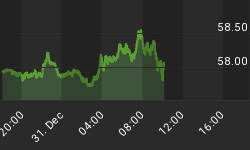What Is Relative Demand Telling Us About Stocks and The Economy?
Businesses Appear More Confident
The U.S. economy is highly dependent on consumers buying and consuming. It is much easier to buy and consume when you are employed. Consequently, investors monitor the labor market very closely. Wednesday brought some encouraging news on that economic front. From The Wall Street Journal:
U.S. businesses added jobs at a quick pace last month, notably in construction, according to a tally of hiring released Wednesday. Private-sector payrolls increased by 238,000 positions in December, according to the national employment report compiled by payroll processor Automatic Data Processing Inc. and forecasting firm Moody's Analytics. The gain is the highest ADP estimate since November 2012. "My sense is businesses are feeling good," said Mark Zandi, chief economist at Moody's Analytics. "CEOs are deciding it's time to expand."
Relative Demand As Polling Mechanism

The expression "put your money where your mouth is" applies to the market's pricing mechanism; the same mechanism that determines the value of your investment portfolio. When investors are confident about future economic outcomes, they prefer to be in growth-oriented stocks. When they are fearful, they prefer the relative safety of bonds. You can argue interest rates skew the value of this analysis, which is valid in the short-run. However, stock corrections and bear markets are deflationary events, which means the longer fear persists, eventually bonds will be in greater demand than stocks.
2011: Bond Demand Was Waving Yellow Flags
As investors, we would prefer to reduce our exposure to stocks prior to, or in the early stages of, a sharp decline in prices (see point B below). The meat of the chart below tracks investor demand for stocks (SPY) relative to bonds (AGG). When the ratio falls, it is indicative of rising demand for conservative bonds relative to growth-oriented stocks. Notice the ratio was making a series of lower highs and lower lows (see 1-5 below) before the plunge in stocks near point B. Rising fear was observable five months before point B, sending a "be careful with stocks" signal.

2014: Our Survey Says
How does the stock vs. bond poll look in early 2014? Much better than it did in 2011. Rather than making a series of lower highs and lower lows (bearish for stocks), the ratio is making a series of higher highs and higher lows (bullish demand for stocks relative to bonds).

If you are still skeptical of using a stock/bond ratio in a rising rate environment, Tuesday's analysis looked at a similar risk-on vs. risk-off ratio (long vs. short); the results are very similar - still bullish.
Rate Of Growth Expected To Pick Up
The Fed's QE process has unquestionably contributed to the recent rise in risk assets, such as stocks. The most recent Fed minutes were released Wednesday. The basic takeaway was the economy is improving from the Fed's vantage point, which increases the odds of additional tapering. From MarketWatch:
Meeting participants viewed the information received over the intermeeting period as suggesting that the economy was expanding at a moderate pace. They generally indicated that the broad contours of their outlook for real activity, the labor market, and inflation had not changed materially since their October meeting, but most expressed greater confidence in the outlook and saw the risks associated with their forecasts of real GDP growth and the unemployment rate as more nearly balanced than earlier in the year. Almost all participants continued to project that the rate of growth of economic activity would strengthen in coming years, and all anticipated that the unemployment rate would gradually decline toward levels consistent with their current assessments of its longer-run normal value."
Investment Implications - Treading In Bullish Waters
Uncertainty about the strength of the economy relative to Fed tapering has contributed to a pause in stocks. However, the pause has not yet resulted in any significant changes in the observable evidence tracked by our market model. Consequently, we continue to maintain significant positions in U.S. stocks (VTI), financials (XLF), energy (XLE), small caps (IJR), Europe (FEZ), and global stocks (VT). If the current stall morphs into weakness, we will be watching how buyers and sellers interact near the key S&P 500 levels shown below. We will continue to let the market be our guide.

















